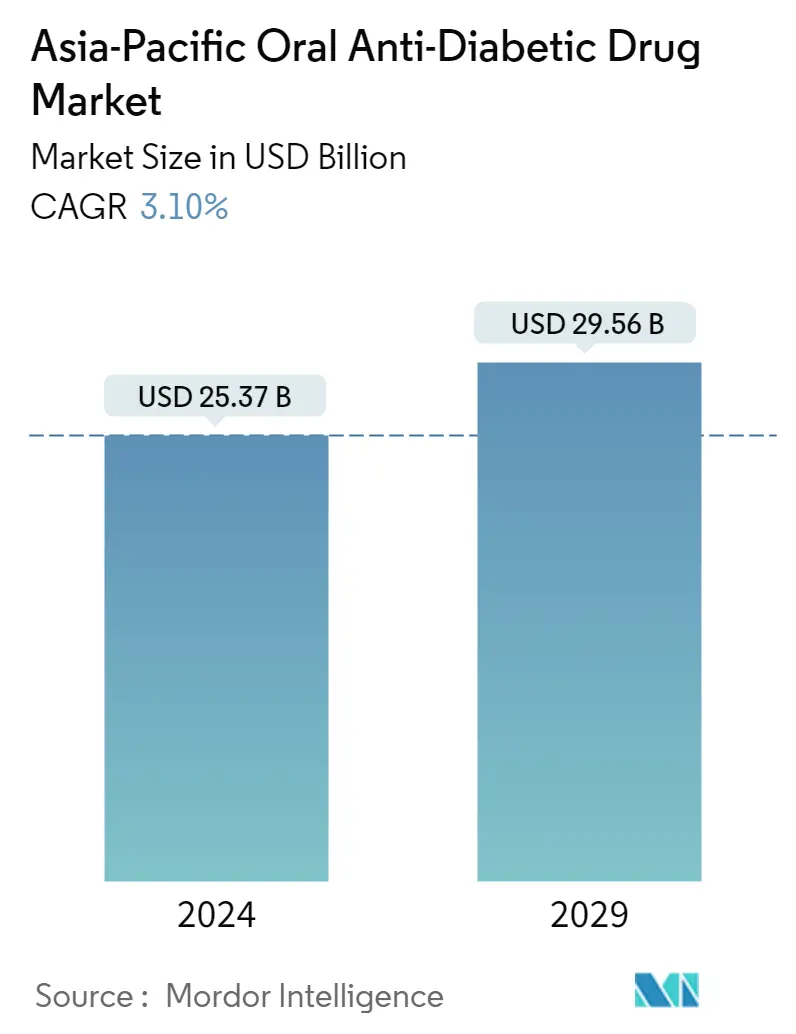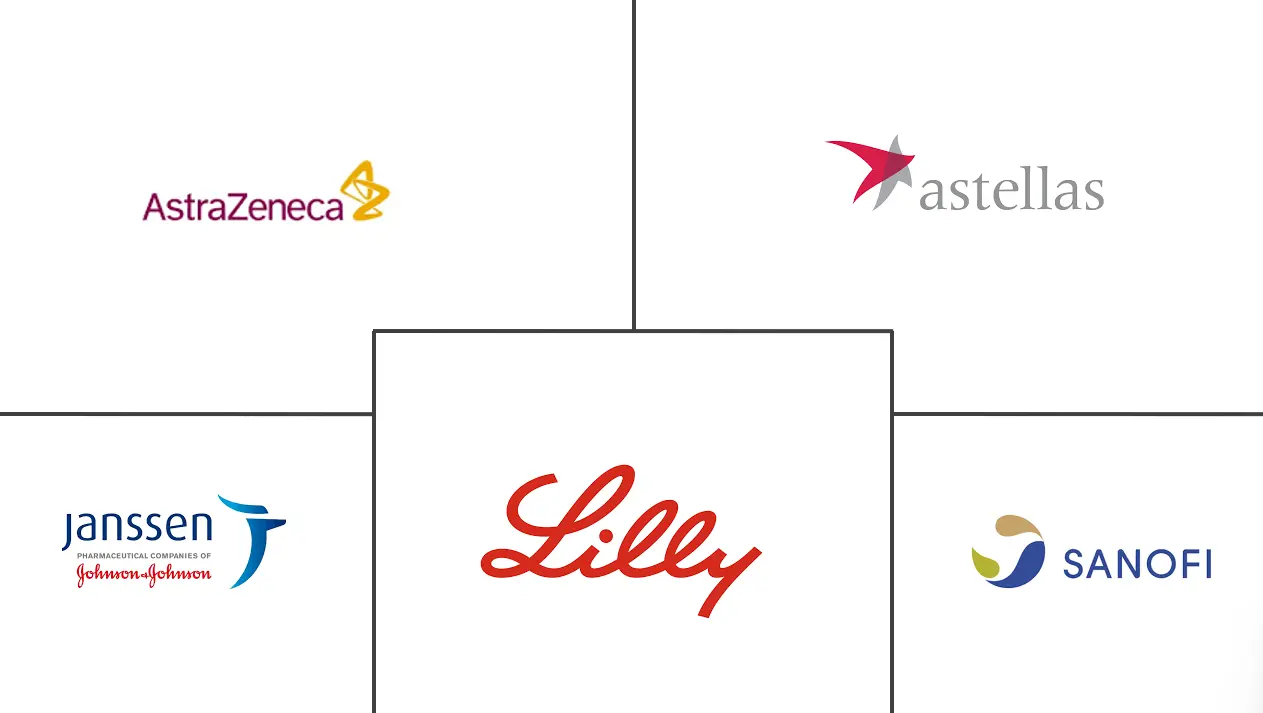Market Size of Asia-Pacific Oral Anti-Diabetic Drug Industry

| Study Period | 2019 - 2029 |
| Base Year For Estimation | 2023 |
| Forecast Data Period | 2024 - 2029 |
| Market Size (2024) | USD 25.37 Billion |
| Market Size (2029) | USD 29.56 Billion |
| CAGR (2024 - 2029) | 3.10 % |
Major Players
*Disclaimer: Major Players sorted in no particular order |
APAC Oral Anti-Diabetic Drug Market Analysis
The Asia-Pacific Oral Anti-Diabetic Drug Market size is estimated at USD 25.37 billion in 2024, and is expected to reach USD 29.56 billion by 2029, growing at a CAGR of 3.10% during the forecast period (2024-2029).
COVID-19 caused a gradual rise in demand for diabetes medications in the Asia-Pacific region. Patients with COVID-19 and pre-existing diabetes had blood glucose level changes, according to a study by BeatO in 2021 on 800 people, which finally resulted in a significant demand for cutting-edge medications to treat diabetes. In order to decrease the severe effects of COVID-19, Novo Nordisk has introduced a new social responsibility strategy to fight diabetes and give patients access to low-cost diabetes care in every nation.
Asian nations have seen a sharp rise in the number of people with diabetes over the past few decades, particularly those with type 2. More than 70% of people with diabetes live in developing nations. The Asia-Pacific region is expected to see significant growth as a result of an aging population and an increase in diabetes prevalence, which is mostly caused by increased stress levels, sedentary lifestyles, smoking, and excessive alcohol use that raises blood sugar levels. Also, the production infrastructure of some antidiabetic medicine manufacturers in the area contributed to the market expansion. However, one of the main commercial restraints is thought to be the rising cost of pharmaceuticals.
Biguanides, sulfonylureas, meglitinide, thiazolidinedione (TZD), dipeptidyl peptidase 4 (DPP-4) inhibitors, sodium-glucose cotransporter (SGLT2) inhibitors, glucosidase inhibitors are the main groups of oral antidiabetic drugs.
APAC Oral Anti-Diabetic Drug Industry Segmentation
Antihyperglycemic medications are taken orally to lower blood glucose levels. They are frequently employed in the management of type 2 diabetes. The Asia-Pacific Oral Anti-Diabetic Drug Market is set to witness a CAGR of more than 3% during the forecast period. The Asia-Pacific Oral Anti-Diabetic Drug Market is segmented into drugs (Biguanides, Alpha-glucosidase inhibitors, Dopamine-D2 receptor agonists, Sodium-glucose Cotransport-2 (SGLT-2) inhibitor, Dipeptidyl Peptidase-4 (DPP-4) Inhibitors, Sulfonylureas, and Meglitinides), and Geography. The report offers the value (in USD million) and volume (in Units million) for the above segments.
| Oral Anti-diabetic drugs (Value and Volume, 2017 - 2028) | ||||||
| ||||||
| ||||||
| ||||||
| ||||||
| ||||||
| ||||||
|
| Geography | |||
| |||
| |||
| |||
| |||
| |||
| |||
| |||
| |||
| |||
| |||
|
Asia-Pacific Oral Anti-Diabetic Drug Market Size Summary
The Asia-Pacific oral anti-diabetic drug market is poised for growth, driven by an increasing prevalence of diabetes, particularly type 2, in the region. This rise is attributed to factors such as an aging population, sedentary lifestyles, and lifestyle choices like smoking and excessive alcohol consumption. The market is characterized by the dominance of metformin, a widely prescribed biguanide-class medication, due to its favorable risk/benefit ratio and cost-effectiveness. The region's market expansion is further supported by advancements in production infrastructure and the introduction of innovative diabetes medications. However, the rising cost of pharmaceuticals presents a significant challenge to market growth.
China and Japan are identified as key markets within the Asia-Pacific region, with China holding a substantial share of the global diabetes medicine market. The presence of numerous generic medication manufacturers in China and the well-organized medical insurance systems in Japan contribute to the market's robustness. Despite Japan's mature market status, it faces challenges such as economic stagnation and an aging population. Leading pharmaceutical companies like Eli Lilly, AstraZeneca, Sanofi, and Janssen Pharmaceuticals are focusing on innovation to capture market share. Recent developments, such as Oramed's oral insulin capsule and Eurofarma's Suganon, highlight the ongoing efforts to enhance diabetes treatment options in the region.
Asia-Pacific Oral Anti-Diabetic Drug Market Size - Table of Contents
-
1. MARKET DYNAMICS
-
1.1 Market Overview
-
1.2 Market Drivers
-
1.3 Market Restraints
-
1.4 Porter's Five Forces Analysis
-
1.4.1 Bargaining Power of Suppliers
-
1.4.2 Bargaining Power of Consumers
-
1.4.3 Threat of New Entrants
-
1.4.4 Threat of Substitute Products and Services
-
1.4.5 Intensity of Competitive Rivalry
-
-
-
2. MARKET SEGMENTATION
-
2.1 Oral Anti-diabetic drugs (Value and Volume, 2017 - 2028)
-
2.1.1 Biguanides
-
2.1.1.1 Metformin
-
-
2.1.2 Alpha-Glucosidase Inhibitors
-
2.1.2.1 Alpha-Glucosidase Inhibitors
-
-
2.1.3 Dopamine D2 receptor agonist
-
2.1.3.1 Bromocriptin
-
-
2.1.4 SGLT-2 inhibitors
-
2.1.4.1 Invokana (Canagliflozin)
-
2.1.4.2 Jardiance (Empagliflozin)
-
2.1.4.3 Farxiga/Forxiga (Dapagliflozin)
-
2.1.4.4 Suglat (Ipragliflozin)
-
-
2.1.5 DPP-4 inhibitors
-
2.1.5.1 Onglyza (Saxagliptin)
-
2.1.5.2 Tradjenta (Linagliptin)
-
2.1.5.3 Vipidia/Nesina(Alogliptin)
-
2.1.5.4 Galvus (Vildagliptin)
-
-
2.1.6 Sulfonylureas
-
2.1.6.1 Sulfonylureas
-
-
2.1.7 Meglitinides
-
2.1.7.1 Meglitinides
-
-
-
2.2 Geography
-
2.2.1 Japan (Value and Volume 2017-2028)
-
2.2.1.1 By Drug (Biguanides, Alpha-glucosidase Inhibitors, Dopamine-D2 Receptor Agonists, SGLT-2 Inhibitors, DPP-4 Inhibitors, Sulfonylureas, Meglitinides)
-
-
2.2.2 South Korea (Value and Volume 2017-2028)
-
2.2.2.1 By Drug (Biguanides, Alpha-glucosidase Inhibitors, Dopamine-D2 Receptor Agonists, SGLT-2 Inhibitors, DPP-4 Inhibitors, Sulfonylureas, Meglitinides)
-
-
2.2.3 China (Value and Volume 2017-2028)
-
2.2.3.1 By Drug (Biguanides, Alpha-glucosidase Inhibitors, Dopamine-D2 Receptor Agonists, SGLT-2 Inhibitors, DPP-4 Inhibitors, Sulfonylureas, Meglitinides)
-
-
2.2.4 India (Value and Volume 2017-2028)
-
2.2.4.1 By Drug (Biguanides, Alpha-glucosidase Inhibitors, Dopamine-D2 Receptor Agonists, SGLT-2 Inhibitors, DPP-4 Inhibitors, Sulfonylureas, Meglitinides)
-
-
2.2.5 Australia (Value and Volume 2017-2028)
-
2.2.5.1 By Drug (Biguanides, Alpha-glucosidase Inhibitors, Dopamine-D2 Receptor Agonists, SGLT-2 Inhibitors, DPP-4 Inhibitors, Sulfonylureas, Meglitinides)
-
-
2.2.6 Vietnam (Value and Volume 2017-2028)
-
2.2.6.1 By Drug (Biguanides, Alpha-glucosidase Inhibitors, Dopamine-D2 Receptor Agonists, SGLT-2 Inhibitors, DPP-4 Inhibitors, Sulfonylureas, Meglitinides)
-
-
2.2.7 Malaysia (Value and Volume 2017-2028)
-
2.2.7.1 By Drug (Biguanides, Alpha-glucosidase Inhibitors, Dopamine-D2 Receptor Agonists, SGLT-2 Inhibitors, DPP-4 Inhibitors, Sulfonylureas, Meglitinides)
-
-
2.2.8 Indonesia (Value and Volume 2017-2028)
-
2.2.8.1 By Drug (Biguanides, Alpha-glucosidase Inhibitors, Dopamine-D2 Receptor Agonists, SGLT-2 Inhibitors, DPP-4 Inhibitors, Sulfonylureas, Meglitinides)
-
-
2.2.9 Philippines (Value and Volume 2017-2028)
-
2.2.9.1 By Drug (Biguanides, Alpha-glucosidase Inhibitors, Dopamine-D2 Receptor Agonists, SGLT-2 Inhibitors, DPP-4 Inhibitors, Sulfonylureas, Meglitinides)
-
-
2.2.10 Thailand (Value and Volume 2017-2028)
-
2.2.10.1 By Drug (Biguanides, Alpha-glucosidase Inhibitors, Dopamine-D2 Receptor Agonists, SGLT-2 Inhibitors, DPP-4 Inhibitors, Sulfonylureas, Meglitinides)
-
-
2.2.11 Rest of Asia-Pacific (Value and Volume 2017-2028)
-
2.2.11.1 By Drug (Biguanides, Alpha-glucosidase Inhibitors, Dopamine-D2 Receptor Agonists, SGLT-2 Inhibitors, DPP-4 Inhibitors, Sulfonylureas, Meglitinides)
-
-
-
Asia-Pacific Oral Anti-Diabetic Drug Market Size FAQs
How big is the Asia-Pacific Oral Anti-Diabetic Drug Market?
The Asia-Pacific Oral Anti-Diabetic Drug Market size is expected to reach USD 25.37 billion in 2024 and grow at a CAGR of 3.10% to reach USD 29.56 billion by 2029.
What is the current Asia-Pacific Oral Anti-Diabetic Drug Market size?
In 2024, the Asia-Pacific Oral Anti-Diabetic Drug Market size is expected to reach USD 25.37 billion.

